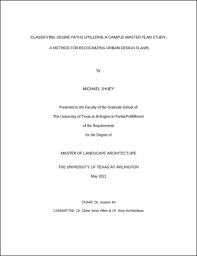
ATTENTION: The works hosted here are being migrated to a new repository that will consolidate resources, improve discoverability, and better show UTA's research impact on the global community. We will update authors as the migration progresses. Please see MavMatrix for more information.
Show simple item record
| dc.contributor.advisor | Im, Joowon | |
| dc.creator | Shuey, Michael | |
| dc.date.accessioned | 2021-06-01T21:05:40Z | |
| dc.date.available | 2021-06-01T21:05:40Z | |
| dc.date.created | 2021-05 | |
| dc.date.issued | 2021-05-07 | |
| dc.date.submitted | May 2021 | |
| dc.identifier.uri | http://hdl.handle.net/10106/29831 | |
| dc.description.abstract | Desire paths are the informal pathways created from the erosional effect of repeated foot traffic. These footpaths come in many shapes and sizes and can occur in spaces where there are no formal pathways for pedestrians. However, in many developed urban and natural areas, desire paths may appear within a landscape that has been intentionally designed. In some perspectives, desire paths can represent user dissatisfaction with the pedestrian landscape, as well as a failure of the urban design process.
Recent literature on this topic considers the environmental, economic, and social impacts caused by desire path occurrences. However, desire paths are a pedestrian’s response to the surrounding environment and are a symptom of larger urban planning decisions. According to Lang (2017), urban design is often treated as cosmetic, when in fact its role in city planning considers the relationship between the networks of public streets and open spaces, as well as the overall quality of the public realm. When the holistic considerations of urban design are neglected in planning efforts, there are unintended consequences that can impact pedestrian experience (Lang, 2017). The objective of this research is to study desire path occurrences on a university campus master plan in the Dallas Fort Worth metroplex. This study includes a record of desire paths, as well as their surrounding environments (street networks and public spaces) at multiple scales, to better understand the planning decisions that led to their creation and how to improve them. This research aims to consider how desire paths can relate to a larger urban design context, rather than simply an isolated landscape design issue.
The methodology used was a combination of descriptive research strategies including qualitative and quantitative methods. The University of North Texas campus master plan was studied as an urban form assimilating open spaces and street networks. The site was selected based on high pedestrian population, desire path occurrences, walkable scale, and similar urban design structure. Qualitative methods included field observation/inventory of desire paths and their surrounding conditions, as well as a modified case study for each campus using the Landscape Architecture Foundation Case Study Guide (2020). Analysis methods drew on mapping techniques, descriptive statistics outlined by Sommer and Sommer (2001), and a typology classification scheme defined by Deming and Swaffield (2011).
The products of this research contain desire path typologies, including a transect and plan diagram of their surrounding conditions. The typology coincides with design implications for landscape architects, urban planners, and designers, to better recognize design flaws during the design process. The significance of this research explores how a stronger understanding of desire paths and pedestrian behavior, can lead to better design quality of urban landscapes. | |
| dc.format.mimetype | application/pdf | |
| dc.language.iso | en_US | |
| dc.subject | Desire path | |
| dc.subject | Urban design | |
| dc.subject | Landscape | |
| dc.subject | Pathway | |
| dc.subject | Path | |
| dc.subject | Campus | |
| dc.subject | Planning | |
| dc.title | CLASSIFYING DESIRE PATHS UTILIZING A CAMPUS MASTER PLAN STUDY: A METHOD FOR RECOGNIZING URBAN DESIGN FLAWS | |
| dc.type | Thesis | |
| dc.degree.department | Landscape Architecture | |
| dc.degree.name | Master of Landscape Architecture | |
| dc.date.updated | 2021-06-01T21:05:41Z | |
| thesis.degree.department | Landscape Architecture | |
| thesis.degree.grantor | The University of Texas at Arlington | |
| thesis.degree.level | Masters | |
| thesis.degree.name | Master of Landscape Architecture | |
| dc.type.material | text | |
Files in this item
- Name:
- SHUEY-THESIS-2021.pdf
- Size:
- 10.21Mb
- Format:
- PDF
This item appears in the following Collection(s)
Show simple item record


